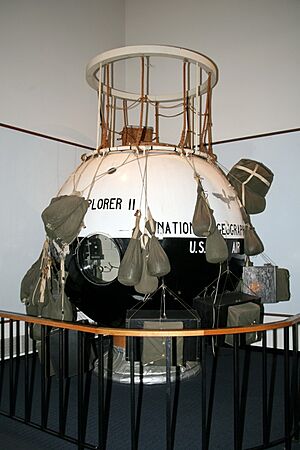Stratobowl facts for kids
The Stratobowl is a special natural bowl-shaped area found within the Black Hills National Forest in South Dakota. It's located southwest of Rapid City. This unique spot was used in the 1930s and 1950s as a launch site for huge stratospheric balloons.
In 1934 and 1935, it was called Stratocamp. This project was a partnership between the National Geographic Society and the United States Army Air Corps. Later, from 1956 to 1959, the U.S. Navy used the same site for their Project Strato-Lab balloon launches.
Contents
Explorer Balloons: Early Adventures
In 1934, the National Geographic Society and the Army Air Corps teamed up. They wanted to launch a large, manned high-altitude balloon called the Explorer. This balloon was designed to fly very high, into the stratosphere.
After a Soviet balloon crashed, the main goal changed. Instead of just setting altitude records, the team focused on science. They wanted to do research and test new navigation tools.
Finding the Perfect Launch Spot
The pilots chosen for the Explorer were Captain Albert William Stevens, Captain Orvil Arson Anderson, and Major William Ellsworth Kepner. Kepner and Anderson, who were experienced balloonists, were in charge of finding the best launch site.
They looked for a place that was like a natural bowl or canyon. It needed to be a clear, grassy valley surrounded by tall rocky ridges. These ridges would protect the huge balloon from wind before launch. The ideal spot also needed electricity, roads, and even a fishing stream! They found their perfect spot near Rapid City, South Dakota. Local officials were excited about the publicity and helped build a road and bring in electricity.
Building Stratocamp
Captain Anderson led the building of a temporary village at the Stratobowl. Over 100 people lived and worked there, with help from the South Dakota National Guard and the army. A large launch pad, about 200 feet wide, was covered with sawdust. This soft surface protected the balloon's fabric when it was spread out on the ground. News about the preparations was shared across the country.
The First Explorer Flight
The Explorer balloon lifted off at 6:45 AM on July 28, 1934. This exciting event was broadcast live on the radio. About 30,000 people watched from the site.
After seven hours in the air, the pilots saw holes in the bottom of the gas bag. The balloon quickly lost gas and began to fall fast. At about 5,000 feet, the remaining hydrogen gas exploded. The pilots managed to parachute out and all three survived without injury. The Explorer flight missed setting a world record by only 624 feet. The accident happened because the balloon's fabric folded, causing too much stress as it expanded high up.
The Explorer II Success
Despite the accident, the National Geographic Society and the Army Air Corps decided to try again. They planned a new launch for June 1935. The new balloon, Explorer II, was filled with helium (a safer gas) and was ready in November.
On November 11, 1935, Explorer II lifted off at 8:00 AM. About 20,000 people watched this launch. The balloon reached a new world record height of 72,395 feet (22,066 meters). Anderson, Kepner, and Stevens became the first people to clearly see the Earth's curvature from such a high altitude.
Strato-Lab Balloons: Scientific Missions
In the 1950s, the Stratobowl was used again for balloon launches. These were part of the U.S. Navy's Project Strato-Lab. While other sites were sometimes used, the Stratobowl was a backup location.
There was one Strato-Lab launch in 1956, three in 1958, and seven in 1959. On November 8, 1956, the Strato-Lab I gondola carried Malcolm Ross and M. L. Lewis from the Stratobowl. They set a new world altitude record for manned balloon flight, reaching 76,000 feet (23,165 meters). The goal of this flight was to collect important scientific data. This included information about weather, cosmic rays, and other things needed to make high-altitude flights safer.
The most famous Strato-Lab flight was Strato-Lab IV. It was piloted by Malcolm Ross and Charles B. Moore. They lifted off from the Stratobowl on November 28, 1959. This flight reached an amazing altitude of 81,000 feet (24,689 meters). After 20 hours in the air, they landed safely in Kansas. The main purpose of this flight was to study the planet Venus using special equipment. They wanted to get a clearer view without much interference from Earth's atmosphere.
Images for kids



